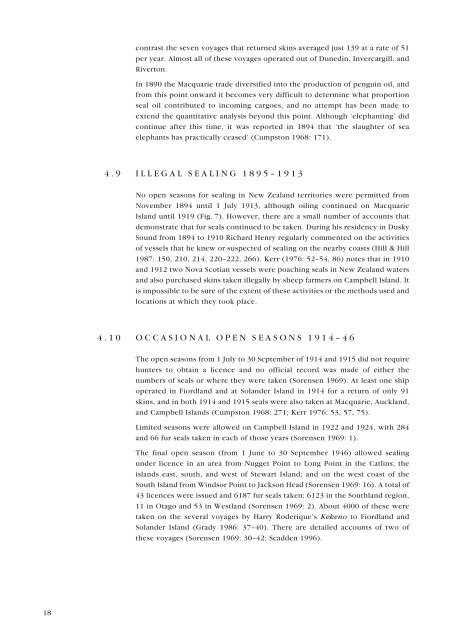The New Zealand Sealing Industry - Department of Conservation
The New Zealand Sealing Industry - Department of Conservation
The New Zealand Sealing Industry - Department of Conservation
You also want an ePaper? Increase the reach of your titles
YUMPU automatically turns print PDFs into web optimized ePapers that Google loves.
contrast the seven voyages that returned skins averaged just 139 at a rate <strong>of</strong> 51<br />
per year. Almost all <strong>of</strong> these voyages operated out <strong>of</strong> Dunedin, Invercargill, and<br />
Riverton.<br />
In 1890 the Macquarie trade diversified into the production <strong>of</strong> penguin oil, and<br />
from this point onward it becomes very difficult to determine what proportion<br />
seal oil contributed to incoming cargoes, and no attempt has been made to<br />
extend the quantitative analysis beyond this point. Although ‘elephanting’ did<br />
continue after this time, it was reported in 1894 that ‘the slaughter <strong>of</strong> sea<br />
elephants has practically ceased’ (Cumpston 1968: 171).<br />
4.9 ILLEGAL SEALING 1895–1913<br />
No open seasons for sealing in <strong>New</strong> <strong>Zealand</strong> territories were permitted from<br />
November 1894 until 1 July 1913, although oiling continued on Macquarie<br />
Island until 1919 (Fig. 7). However, there are a small number <strong>of</strong> accounts that<br />
demonstrate that fur seals continued to be taken. During his residency in Dusky<br />
Sound from 1894 to 1910 Richard Henry regularly commented on the activities<br />
<strong>of</strong> vessels that he knew or suspected <strong>of</strong> sealing on the nearby coasts (Hill & Hill<br />
1987: 150, 210, 214, 220–222, 266). Kerr (1976: 52–54, 86) notes that in 1910<br />
and 1912 two Nova Scotian vessels were poaching seals in <strong>New</strong> <strong>Zealand</strong> waters<br />
and also purchased skins taken illegally by sheep farmers on Campbell Island. It<br />
is impossible to be sure <strong>of</strong> the extent <strong>of</strong> these activities or the methods used and<br />
locations at which they took place.<br />
4.10 OCCASIONAL OPEN SEASONS 1914–46<br />
<strong>The</strong> open seasons from 1 July to 30 September <strong>of</strong> 1914 and 1915 did not require<br />
hunters to obtain a licence and no <strong>of</strong>ficial record was made <strong>of</strong> either the<br />
numbers <strong>of</strong> seals or where they were taken (Sorensen 1969). At least one ship<br />
operated in Fiordland and at Solander Island in 1914 for a return <strong>of</strong> only 91<br />
skins, and in both 1914 and 1915 seals were also taken at Macquarie, Auckland,<br />
and Campbell Islands (Cumpston 1968: 271; Kerr 1976: 53, 57, 75).<br />
Limited seasons were allowed on Campbell Island in 1922 and 1924, with 284<br />
and 66 fur seals taken in each <strong>of</strong> those years (Sorensen 1969: 1).<br />
<strong>The</strong> final open season (from 1 June to 30 September 1946) allowed sealing<br />
under licence in an area from Nugget Point to Long Point in the Catlins; the<br />
islands east, south, and west <strong>of</strong> Stewart Island; and on the west coast <strong>of</strong> the<br />
South Island from Windsor Point to Jackson Head (Sorensen 1969: 16). A total <strong>of</strong><br />
43 licences were issued and 6187 fur seals taken; 6123 in the Southland region,<br />
11 in Otago and 53 in Westland (Sorensen 1969: 2). About 4000 <strong>of</strong> these were<br />
taken on the several voyages by Harry Roderique’s Kekeno to Fiordland and<br />
Solander Island (Grady 1986: 37–40). <strong>The</strong>re are detailed accounts <strong>of</strong> two <strong>of</strong><br />
these voyages (Sorensen 1969: 30–42; Scadden 1996).<br />
18
















